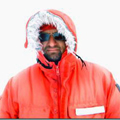Measuring the Lakes beneath the Ice
In this audio dispatch, I describe the work we have been doing since finally reaching our field site.
 3 comments
3 comments In this audio dispatch, I describe the work we have been doing since finally reaching our field site.

 Slawek Tulaczyk focuses on the critical role that ice sheets play in climate and sea-level change. A native of Poland, he's a professor in the Earth and Planetary Sciences department at the University of California, Santa Cruz, and loves the intellectual and physical challenges of working in remote field sites in Iceland, Greenland, and Antarctica.
Slawek Tulaczyk focuses on the critical role that ice sheets play in climate and sea-level change. A native of Poland, he's a professor in the Earth and Planetary Sciences department at the University of California, Santa Cruz, and loves the intellectual and physical challenges of working in remote field sites in Iceland, Greenland, and Antarctica. 














































 Unless otherwise noted, this work is licensed under a Creative Commons Attribution-Noncommercial-Share Alike 3.0 United States License.
Unless otherwise noted, this work is licensed under a Creative Commons Attribution-Noncommercial-Share Alike 3.0 United States License. 
hi dr. im doing a report on some of your work. the dynamics of water and lakes flowing under ice sheets confuses me. can you explain how that is possible?
Avi,
Thanks for your question. Many people are surprised to hear that there is a lot of water movement beneath the Antarctic ice sheet. The first thing one needs to understand is that ice is melting at the bottom in many places; where there is sufficient heat. There are two heat sources, one is the geothermal flux of heat from deep Earth interior and the other one is heat produced by friction during ice motion. The rates of melting are about a fraction of an inch per year. This is ten to hundred times less than rainfall on normal continents. However, it’s enough to feed a sluggish subglacial water system. After it’s generated, subglacial meltwater flows, just like water on surface of the Earth does. It can form streams, rivers, and lakes or flow through pore spaces and fractures in rocks and sediments. The one big difference is that water on the surface of the Earth always flows down slope. However, subglacial water sometimes flows uphill because it is pressurized by the weight of ice up above. In fact, subglacial water flow follows mostly the slope of ice surface, rather than the slope of the bedrock underneath the ice sheet. In places where the ice surface slope is gentle, like near ice divides or beneath some ice streams, subglacial meltwater gets trapped in closed bedrock basins and forms subglacial lakes. Hence, the subglacial water system in Antarctica is in many ways similar to the water systems on other continents, except that it exists beneath thousands of feet of ice.
Hi, I was very interested in your article on “measuring lakes beneath the ice” and am reminded of a programme I saw on BBC television about 18 months ago which was explaining how the Greenland Ice Sheet was disappearing at an alarming rate and how the Polar regions would be free of ice within the next 30 years, all blamed on “Global Warming”.
At the end of the programme, there was a casual mention of a fresh water lake that appeared periodically, bursting through the ice and staying there surrounded by ice without freezing.
I have never been able to find out any more about this phenomenum but have always assumed it to be caused by geothermal activity as described in your article, Greenland being in an area of subterranean activity, and more likely to be the cause of the melting of the ice sheet, than the unproven effect of “Global Warming” Harry Kennard U.K.